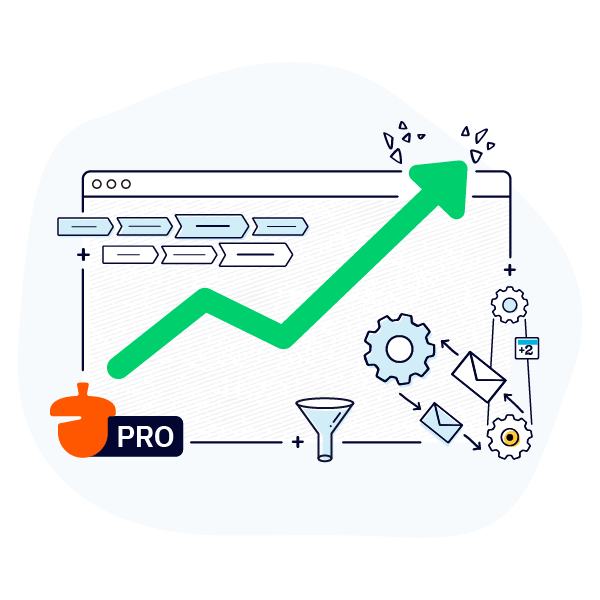
Small and midsize businesses thrive when their sales pipeline is organized, actionable, and aligned with clear follow-up strategies.
Without the right tools, it’s easy to lose deals to missed tasks, inconsistent tracking, or poor visibility into next steps.
The takeaway? A simplified, centralized CRM helps SMBs stay focused, forecast accurately, and close more deals with less chaos.
The one thing a growing business needs– above all else– is sales. For small and mid-sized businesses, it’s important to make more sales while operating as efficiently and budget-wise as possible. A well-managed sales pipeline can help you achieve this.
Read on to learn how to manage a sales pipeline for SMBs, the benefits of doing so, and best practices.
The Sell to Win Playbook collects 55 of the best expert sales tips we’ve ever published. Download it today!

When operating a small to medium-sized business, it’s crucial to ensure you don’t waste precious resources on things that could be outsourced or automated. And that’s especially important in sales.
That’s why a sales pipeline is a must for small teams. It helps your sales team members understand and execute their next action, understand where the customer is in the buyer journey, and spend more time building customer relationships than doing mundane tasks that don’t push the needle.
You may already have a sales pipeline – whether it’s intuitive or on paper (if you had to choose between the two, definitely get it on paper). You can maximize the potential of your sales pipeline by implementing best practices, which we’ll explore in a bit. First, let’s look at the benefits of having a well-managed sales pipeline for your SMB.
Summarize this content with AI:
Taking the time to manage your sales pipeline properly can make a world of difference to your small to medium business. The benefits of a well-managed sales pipeline are numerous, and include:

Now that we understand the importance and benefits of managing your SMB sales pipeline, here are some best practices you can start implementing today.
First things first: if you want to optimize your sales pipeline, you need to understand what it looks like. Your team may already be following an intuitive sales process with varying results. Observe the steps that your sales team takes to close the deal and map these steps.
Generally speaking, the sales pipeline for SMBs usually includes these stages:
Your process may differ slightly depending on your business model and the product or service you offer. When you clearly define the stages of your SMB sales pipeline, you get an objective step-by-step sales process that your team can follow, standardized to make it easier to observe customer behavior and sales rep performance.
DOWNLOAD
If you’re unsure, our list of 101 Task Ideas for Any Sales Process will help you get started.

As a small business, you don’t want to waste time trying to convert your leads into sales. Likewise, your leads despise drawn-out and tedious sales processes. The longer it takes for a lead to move through your sales pipeline, the more likely they’ll get frustrated and move on to a competitor.
A long sales cycle also means that your sales slow down, along with your revenue. Sales are crucial to growing your company, so making your pipeline as efficient and lean as possible is imperative.
There are a few methods to reducing the length of your sales cycle:
We touched on it in a previous point, but this bears repeating because saving as much time as possible when growing your SMB is so important.
Look through your sales pipeline, processes, and tasks. Whenever you find a repetitive activity or a task that can otherwise be completed by a robot, then automate it. For example, if a lead performs a certain action that indicates an interest in learning more about your product, you can install a process that automatically moves them through the pipeline.
And when they enter a new pipeline, you can even automate an email sequence that they receive over the course of a week or two.
It’s important to let your small sales team focus their energy and attention on tasks that a computer cannot do, such as speaking directly to customers or answering complex inquiries and objections.
Sometimes, sales actions and processes that worked well in the previous year won’t work in the next.
Or a sales action could be optimized with new technology.
Or maybe you’re seeing a bottleneck of leads that your team is struggling to move forward with, and you need to troubleshoot the issue.
These are just a few instances that indicate the importance of regularly reviewing your sales pipeline. It’s important to schedule regular reports and audits to check the health of your sales pipeline. Look for opportunities to optimize your sales cycle or update your pipeline to reflect changes in your business model or product.
You can get an accurate view of your sales pipeline performance with a CRM that has reporting and analysis features.
Customer relationship management (CRM) software can be a lifesaver for managing your SMB’s sales pipeline. CRM software lets you define your sales stages and actions, automate tasks, and review reports on pipeline bottlenecks and sales rep performance.
With a CRM like Nutshell, you can create the perfect sales pipeline that meets your business goals and attracts your ideal customer. Go DIY with your pipeline for complete customization, or launch a Nutshell pipeline starter pack for a rapid start, ensuring your time is spent on selling, not pipeline setup.
Some of the benefits of using Nutshell CRM for your small to medium business include:
In addition, when you use Nutshell, you don’t have to splurge on expensive marketing tools. Nutshell’s native add-ons seamlessly integrate with your system when you want to send email marketing campaigns, build landing pages, and do competitor analysis, among other crucial marketing tasks.
With affordable pricing models and endless customization and integration options, Nutshell is an excellent CRM for SMBs who want to manage their sales pipelines and boost business growth.
SMBs often operate with lean teams and limited time, making efficient sales pipeline management crucial. Nutshell is designed with these constraints in mind. It centralizes all your customer data, communications, and sales activities in one intuitive platform, eliminating the need to juggle multiple spreadsheets and tools. Features like automated task reminders, customizable sales processes, and quick data entry mean your team spends less time on administrative overhead and more time selling. By streamlining workflows and providing a clear overview of your pipeline, Nutshell empowers SMBs to maximize their existing resources and focus on high-impact activities.
For SMBs, understanding which metrics truly matter can drive significant growth. In Nutshell, focus on these critical sales pipeline metrics:
Nutshell’s customizable dashboards and reporting tools allow you to visualize these metrics in real-time, helping you make informed decisions and optimize your sales strategy without complex data analysis.
SMBs often pride themselves on their personal touch, and Nutshell helps you scale that without losing authenticity. You can use Nutshell’s automation features to handle repetitive tasks, freeing up your sales team to focus on meaningful, personalized interactions. For example:
This balance of automation and personalization ensures your customers feel valued, not just processed, leading to stronger relationships and higher conversion rates.
Accurate sales forecasting is vital for SMBs to plan resources, manage cash flow, and set realistic goals. Nutshell provides the tools to make this process more reliable:
By maintaining a clean, up-to-date pipeline in Nutshell and regularly analyzing the data, SMBs can significantly improve their sales forecasting accuracy.
Growth is exciting, and Nutshell is built to scale with your SMB. As your sales volume increases and your team expands, Nutshell’s features adapt to support your evolving needs:
Nutshell ensures that your sales pipeline remains organized, efficient, and effective, no matter how big your SMB gets.
Nutshell CRM is an all-in-one solution with a simple goal in mind: helping your business make more sales.
If that sounds like something you want, sign up today for a 14-day free trial of Nutshell—no credit card or payment info required.
We’ll get you started as soon as possible with white-glove contact importing, live demos, and guided tours so that you can hit the ground running. Try Nutshell today!


Join 30,000+ other sales and marketing professionals. Subscribe to our Sell to Win newsletter!
